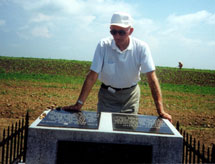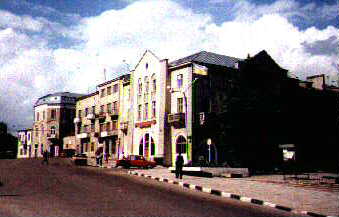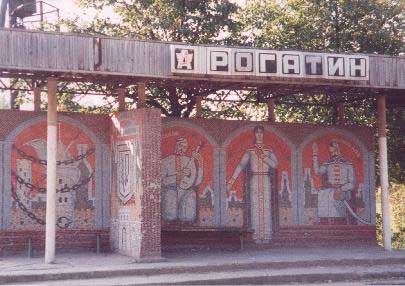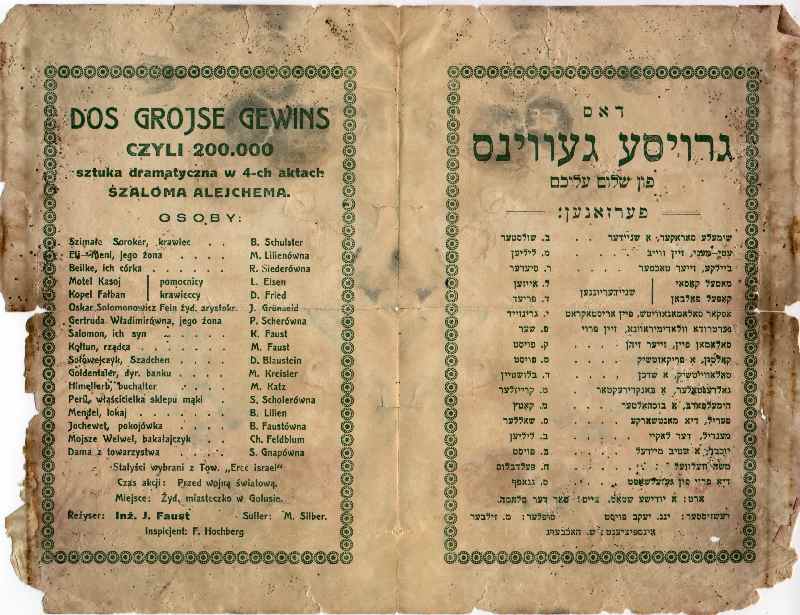

We've collected a number of photographs of Rohatyn and we hope you enjoy viewing them.
If you have one that's especially pertinent, please feel free to send it along (either as a photo or in jpeg format). Please email Phyllis Kramer.My maternal grandmother left her home shtetl, Bukaczowze, in what was Austria-Hungary and is now Ukraine, in 1910. This past May, 2001 I had the opportunity to visit it and explore my personal history, on a trip that included visits to Cracow, Lviv, Poninka, Polonnoye, (my grandfather's towns) and Kiev as well as the Galician towns of my grandmother, Pauline.

We stayed in Ivano-Frankivsk, Stanislau in my grandmother's time, as a base to explore Galicia. From there, we drove through Burstyn and Rohatyn on our way to my grandmother's town of Bukaczowze. In Rohatyn we visited the Holocaust memorial on the site of the mass grave, where most of my grandmother's siblings and their families were slaughtered in 1942. The Holocaust memorial is in the middle of a field, on the outskirts of Rohatyn.
There is one marker, in Cyrillic, which commemorates the Soviet citizens who died during World War II, with no mention of Jews. The more recent monument, put up by Israelis, commemorates the
 3500 Jews from Rohatyn and surrounding communities who were killed by the German in March 1942.
3500 Jews from Rohatyn and surrounding communities who were killed by the German in March 1942.

My relatives who died at this spot were among those 3500. I grew up knowing their names and faces from family photos. I am named for one of my great-aunts and there I was standing at her grave. I don't have the words to tell you how I felt. As a history teacher I have taught the story of the Holocaust countless times. As a genealogist I have thought about it many times. But standing at that place where my Mandel family was actually killed brought it home in a way that nothing else ever has.
The Jewish cemetery stands on a hill a little nearer to town. There are only a few stones left and they are largely illegible. The monument on the cemetery  site reads " In commemoration of the Jewish community of Rohatyn and its surrounding areas that had lived for 600 years and was brutally annihilated by the German Nazis during
the years of 1941-1944." It also indicates that the tombstones were destroyed by the Nazis, during the war.
site reads " In commemoration of the Jewish community of Rohatyn and its surrounding areas that had lived for 600 years and was brutally annihilated by the German Nazis during
the years of 1941-1944." It also indicates that the tombstones were destroyed by the Nazis, during the war.
In 1998 the Israeli Landsmanshaften society wrote to the Mayor of Rogatin to request permission to place a monument in the town. They also wanted to clean up and fence in the old and "new" cemetery sites and the two areas of mass graves (from the Aktions of 1942). These areas were all neglected. The mayor responded positively and met with members of the society. By 1999 the Israeli society collected over $2000 and had a promise of a large donation from an ex-Rohatyner.The monument was erected, and there was a ceremony held in Rohatyn. If you are interested, questions and/or checks can be sent to Israel % Fishel Kirshen, 34 Yonathan Street, Zahala, Tel Aviv 69081.
This photograph at left is of
 Kuba Glotzer, a native of Rohatyn, who returned in June 1998 with his family. The photograph was taken at the monument in Rohatyn and sent to us for publication on this web page.
Kuba Glotzer, a native of Rohatyn, who returned in June 1998 with his family. The photograph was taken at the monument in Rohatyn and sent to us for publication on this web page.
Kuba lost his entire family in Rohatyn during the Holocaust. He was ordered with few other young men from the ghetto, to bury the victims of the March 20th massacre. When it was suggested that he could look for his cousins, with tears in his eyes he said "I buried my cousins in the mass grave where the monument is erected, the one in the photo".
At the liquidation of the Rohatyner Ghetto, Kuba escaped to the woods and survived.
These are photographs of the Kahal Office in Rohatyn in 1938. There are two persons that seem to appear in both photos of the Kahal office. Can you find them? One is the man with the cigarette in his right hand in the first photo and standing on the ladder in the  second.
second.
It is interesting to note the seemingly large number of record books (with labels identifying the contents) appearing on the shelves in the cabinets behind the people.
The Second photo appears to be the older of the two photos. And, do note two the small padlocks on the upper doors.

My grandfather, Wolf Steinmetz mentions in a letter of September 1939 that there were two individuals who were involved in packing up the Jewish Court records in preparation to evacuate the records to Sansk (I'm not sure what Sansk means). He named a Mr. Stein and Seligen. Seligen was the person traveling by rail accompanying the records, on the way to Chadrow (which i believe means Chodorow, the next larger train station going west).
However, it is unclear of what became of the records. Seligen was trying to get the records via the circuitous rail route, which was under bombardment, to safety in Stanislaus. He made it to Stryj, and then beyond Bolechow. The train had to back up to Bolechaw where the Polish authorities freed Seligen and permitted him to go back to Stryj; at the time my grandfather's letter was written he was with the Poles in Stryj. I have no indication at all of what eventually happened to the vital historical records of the Rohatyn Jewish Community!






The cemetery photograph on the left was donated by Howard Steinmetz. Howard said: "This photo was taken in the Jewish Cemetery in Rohatyn in 1918 by my father. I have seen a photo taken by a recent visitor from a similar prospective; the stones are all gone, the trees are all gone; only the church spires in the background are still there, along with our blessed memories of the Jewish Community.
In 1992 the US Commission reported on all the cemeteries in Poland and the Ukraine. The report included the following information on Rogatin:
The cemetery is in the NorthEastern section, near the stadium. The last known Jewish burial was in 1940; It was used mainly by Hasidic Jews. The cemetery is located on a hillside, isolated, marked by no sign or marker; entrance is off a public road; it has no wall,gate or fence; it is used as dump. The cemetery has less than 20 stones, most toppled or broken. Vegetation overgrowth is a constant problem, disturbing graves. Today there are fewer than 10 Jews in Rogatin. (The form was completed by Jewish communite of Kolesnik Victor Pavlovich [ph:(03422)34894].
The photograph of the gravestone below is
from the Jewish Cemetery in Rohatyn

(source: Joan Krotenberg).
Before we complete our information on cemeteries, I wish to share with you an photograph of a Jewish graveyard in the Ukraine. Although this photograph is not from Rohatyn, instead from Chernovitz, when I saw it, and purchased a copy, I felt compelled to talk with the photographer. I asked him if I could add this photograph to my Rohatyn web site, as it evoked in me a strong sense of the history, the warmth and the sadness of European Jewish graveyards. Yuri agreed.
From a short biographical sketch, I extracted the following:
In America, where he has been living
since 1990, Yuri Lev continued professional photography, while working as a computer programmer.
In 1999 he decided to once again devote his full time to photography. He now resides in Cherry Hill,
New Jersey, with his wife, daughter and two cats.
Now, isn't that an amazing photograph!
Here is the family tree: Anschel EICHEL married Beile BERLIN in Rohatyn around 1850.
Their children were:
"Yuri Lev was born in Leningrad, Russia and spent the greater part of his life living in Moscow.
He traveled all across the Soviet Union ...in 1985 ... established his own studio, where he
taught...photography. His works appeared in major publications such as Life and The New York Times
Magazine as well as other American and Russian magazines. 
. .
The EICHELs of Rohatyn by Phyllis Kramer
 My great grandmother Dora EICHEL was born in Rohatyn
in 1862. Dora married Reuven LINDNER (photo circa 1893).
Dora's father, Anschel EICHEL
was a tailor who specialized in making uniforms for the Pravoslav priests and
monks. We can trace the Eichels back to Yitzhak Eichel, who lived in Hamburg at
the end of the 18th century; he was a scholar who published a textbook of the
Yiddish language and was a pupil of the German philosopher Kant.
My great grandmother Dora EICHEL was born in Rohatyn
in 1862. Dora married Reuven LINDNER (photo circa 1893).
Dora's father, Anschel EICHEL
was a tailor who specialized in making uniforms for the Pravoslav priests and
monks. We can trace the Eichels back to Yitzhak Eichel, who lived in Hamburg at
the end of the 18th century; he was a scholar who published a textbook of the
Yiddish language and was a pupil of the German philosopher Kant.
 are pictured at the left in 1944: Mark, Pauline, Jack, Sadie, Izzie, Annie (my gm) & Charlie. The
photograph on the right is the next generation,
are pictured at the left in 1944: Mark, Pauline, Jack, Sadie, Izzie, Annie (my gm) & Charlie. The
photograph on the right is the next generation,
 the American children of these immigrants.
the American children of these immigrants.
. .
The Faust Family Kappella from Rohatyn, 1912
by Alexander Feller, August 2005
Do any Rohatyner decscendents have any pictures of musicians in their personal collections?
I have many pictures from Rohatyn of relatives that also contain persons
that I can not identify and may be just friends. For instance, the musical group below.

Those I can identify are, from top right to left: David Faust
(violin), Itsik Hersch Faust (flute), unknown (the badken), Yankel Faust (trumpet),
Mendal Bass (bass), and Mautra Schmiel Faust (clarinet). Sitting from right is
Wolf Zimbler (viola), Moses Faust (violin). This photo is a scan from the original
photo and handed down through my
Faust relatives. If you have any photos of these musicians playing other than this one, I woud
be interested in viewing them. Any information into the identities of the bassist, the badken,
or Wolf Zimbler, please relay that to me Alexander Feller
The attached playbill is for a play called "The Big Lottery" written by Sholom Alichem and
performed in 1924 in Rohatyn. The play was directed by Jack Faust and actors included other

members of the Faust family such as Max, Kalman, and Bertha. Listed on the play are other actors
and contributors from Rohatyn. This photo is courtesy of the Faust Family Collection.
Alexander Feller August 2007
One last note: the nearby town of Bukachevtsy also has a shtetlinks site, and there are quite a
number of wonderful photos of the Blitz family recently added by the author of that page (Cipora
Blitz's mother was a Faust from Rohatyn and her father a Blitz from Bukachevtsy); to see them
go to: http://www.shtetlinks.jewishgen.org/Bukaczowce/Blitz.htm.
The earliest record of the SNOW family reaches back to Eleazer-Wolf SCHNEE born and raised in the town of Rohatyn, not far from the big city of Lemberg, Austria. After the second World War, when the Soviets took possession of the area the name was changed to Lvov.
Eleazor-Wolf lived to be 102 and died in 1898. That implies that he was born in 1796. He served in the Austrian army for seven years and was rewarded for excellence the right to sell salt, which was a government run monopoly.
With this advantage he established a successful general store. He obtained a water powered mill where the farms had their grains ground. This led to a thriving cattle and lumber trade which extended into Russia.
He had three sons, Gudle, Hersch and Chaskle. My father remembers him as a giant of a man who was very vigorous and very alert. When advanced in years he gave the general store to Gudle, the mill to Chaskle and the cattle and lumber business to Hersch, and went to live with his married grandson Fahvish.
My record is incomplete.
Gudle had several children. Yoineh who went into the grocery business in NYC. Abe Schnee's father came to Philadelphia. My mother spoke of him as a brilliant fine man. Mrs ? Mandle who brought her ailing husband to me for medical advice; she impressed me as a gentle caring wife. A son whose idealism led him to Palestine from where he shortly returned coming to NYC. He came to live with is nephew, my father, Isaac, until he got established. He told us that the Jews in Palestine where not trained to be pioneers then. A daughter, Freda-Hannah married Mr. nathan and went to live in Dayton Ohio. She and my father would like to get married, but dismissed this idea because of the danger of first cousin marriages.
Chaskle married Sara. Their children:
Moses lived in Toronto, operated a furniture business. A son became business manager for the hatter's union. A grandson was
in the USA war as a sky diver.
Schmeel (Sam) farmed in Connecticut, near Bridgeport, dairy and summer guests. Eight children, not known to me.
Shulam (Solomon) leading Socialist. Eight children. One, Eleazer (William) inventor of airplane equipment. Sheriff of Bridgeport,
reelected several times Declined after refusing to favor Socialists for positions in government.
Fahvish married Mahtle. Farmed in Connecticut near Bridgeport. Eight children, all educated in one room school.
Eleazer (Bill) self educated himself, with unskilled help built a modern dairy barn to house 150 milking cows.
The children Israel, Charlie, Moses, Rahtza, Fannie, Annie, Esther all settled in the Bridgeport area, where there are a large
number of their offsprings.
Fannie married Louis (Leibish) Baumrind. Baking operation. Two daughters, Sadie and Bessie.
Sadie married her second cousin
Abe Schnee. During World War I Abe became very successful in real estate deals, Bridgeport was becoming an important munitions center.
When he was 39 he went to Carlyle in Pennsylvania where in one year he got his law degree. He became economics advisor to
Woolworths. He showed them that after they built a store they should sell it and take a long lease. Instead of saving 5% on interest,
the frequent turn-over in product sale even on a low markup would earn several times the 5%. He helped to select new store locations
all over the country. Sadie and Abe had three children. Charles became a moving picture director for MGM. Won an Oscar.
Was beloved by all of the workers. Thelma became an actress. In the play The Corn is Green she outskilled Ethyl Barrymore in my opinion.
She married -- Moss. Together they produced and directed a movie The Dectective which gave Alec Guiness his start. Shortly her husband died and she
dedicated her life to psychology. Betty got a medical degree but shortly died of cancer.
Molly was the other of the eight children. She was married to a Mr. Schwartz but had no children. When he died she went to live on the farm
with her brother Fahvish.
Louis (Leibish) was the youngest child for Chaskle. He was a very gentle person. His first wife disppeared. he travelled about,
landing in Buffalo, where he took on his common law wife; eventually they were married. They had two daughters, Louise and Bettie. Both
were nurses. Bettie married her first cousin Bill, Fahvish's son. They had two children. The son is an albino. he is almost blind, still with
his mother's help he went through college and began to teach. The daughter also has albinism with partial loss of vision. She is
able to write and corresponds with me. Louis was deeply interested in philosophy as were his brothers. He soap box lectured in a
park in Buffalo. He was roughed up by rowdies who accused him of being a Socialist. He wrote two books of poetry, all very sad.
Itzik (Isaac) married Annie, six children. Bakery business in NYC.
Dora married William Intner. Mattress manufacture. Commercial real estate incentral Manhattan. Three children, Melvin, Matthew, Mildred.
Melvin and Matthew -real estate. investments. Mildred - dealer in arts of nineteenth century.
William (Eleazer-Wolf) physician. Marry Amy 62 years. She was a xray technician. Married Maggie Duncan.
She trained as a horticulturalist. Taught school. Now publisher and editor of nature column.
Charlie (chaskle) Baker. Chief steward transatlantic liners. Manager William intner mattress factory Married-Nettie. Three children-Diana, Howard, Diane.
Diane-hair dresser; her son dean of college. Howard-computer operations in a bank in NYC.
Benjamin Baker; glass installation. Married to Elsie. Three daughters. Florence's son a stock broker with Solomon Brothers Wall
Street. Mindie-schoolteacher, Thema housewife.
Fannie married Goerge Gang. Housewife. Son industrial engineer, changed to education. Philip lecturer for United Nations. Daniel-
glass industries. His son lecturer for computer operations for United Nations. Ruth-secretarial work.
Esther married Max Pitch who was a certified public accountant.They were world travelers. Her daughter, Riva is a physician who is
doing eye surgery One son Herbert operates a private school in NYC. One son Donald was in the glass business, is retired leaving the
operations to his son.
William and Amy progeny
Barbara entered MIT at age 15. Honor student. Physician skilled in psychiatry, married to Dr Leon Sokoloff, world authority on
arthritis, lectures worldwide by invitation. Their son Michael is a professor of physics at Cinncinnate University in Seattle. Their daughter
Naomi is a professor of Hebrew at Washington University in Seattle. Published books in Hebrew, one on child care. Paul- pathologist. General
practice, married to Faye, who operates a ballet and aerobics school. Soon taking a ballet troupe to Europe. Daughter Wendy designs
clothes for theater.
My children and grandchildren are very interested in reading about their roots. In the Yizkor Book there is an article by Jack's Uncle Zev Barban. Too bad that Jack is not alive to read it. In his immediate family, Jack was the only survivor after the Holocaust. He gave his testimony to the Shoah Spielberg foundation . The copy of his biography could be found in Yad Vashem and also in the United States Holocaust Memorial Museum.
Jack’s entire family came from Rohatyn. He told us:
My maternal grandparents, Leah and Kalman Yankel Barban lived and died in Rohatyn. My father Meyer Glotzer emigrated to the United States. My mother Toba Barban Glotzer perished in the holocaust along with my uncles/aunts Morris Barban and Golda and Wolf Rappaport. Zissel and Joseph Loew immigrated to the US.
My brothers Samuel and Moshe Glotzer perished in the Shoa, along with my aunts and uncles Iser and Esther Glotzer, Jack and Goldie Glotzer, Malka Glotzer Altman, and Malka Glotzer. Uncle Max Altman came to the United States, along with aunts Chane Kuperman, Rose Altman, Jeni Hecht and Charne Schwartz.
Thank you very much
Bea.
Return to Rohatyn's Table of Contents

The following was sourced Rohatyn Business Directories, Rohatyn Tax Rolls, JRI-Poland, Private Researchers LDS microfilms and Miriam Weiner’s database (details below the table):
| Item | Repository/Source | Details | Comments | Voters List | LDS microfilm | 1870 | Indexed and on Our Surname Listing | Business Directory | JewishGen | 1923 | Indexed and on Our Surname Listing | Galician Business Directory | JewishGen | 1891 | Indexed and on our Surname Listing | Army/Military Record | State Archive-IvanoFrankovsk | 1900-1908; 1919-1923 | Army/Military Record | Historical Archives-Lviv | 1849-1945 | Hired Researcher 10/08 for inventory | Birth | AGAD-Warsaw | 1859-1881; 1884; 1898-1905; 1914; 1922; 1934; 1938-1939 | JRI-P has indexed 1859-1881;1889 | Birth | USC-Warsaw | 1906-1922; 1931-1939 | Death | AGAD-Warsaw | 1877-1886; 1914; 1938-1939 | JRI-P has indexed 1877-1886, 1887-1898 | Death | USC-Warsaw | 1899-1942 | Voter Lists | State Archive-IvanoFrankovsk | 1933; 1938 | Immigration Records | State Archive-IvanoFrankovsk | 1919-20 | Migration – to Israel (alijah passports) | Jewish Historical Institute-Warsaw | 1929-1939 | Holocaust Records | State Archive-IvanoFrankovsk | 1941-1945 | Index | State Archive-IvanoFrankovsk | 1918-1937 (poviat) | Kahal/Jewish Community Records | State Archive-IvanoFrankovsk | 1920-1939; 1921-22,1935-8(poviat) | Land/Business Owners | State Archive-IvanoFrankovsk | 1926-7 1924-7(poviat) | Property Records | Historical Archives-Lviv | 1785-1788; 1819-1820; 1822; 1846-1879; 1880 | Hired Researcher 10/08 for inventory | Marriage | AGAD-Warsaw | 1923; 1925; 1927; 1935; 1938-1939 | Marriage | USC-Warsaw | 1908-1912; 1923; 1925; 1927; 1935; 1938-1939 | Police/KGB Files | State Archive-IvanoFrankovsk | 1920-1930; 1919-1938(poviat) | Reference/Address B ooks | State Archive-IvanoFrankovsk | 1926-1927 1926-7(poviat) | Jewish School Students | Historical Archives-Lviv` | 1923-1939 | Hired Researcher 10/08 for inventory | Jewish School Students | State Archive-IvanoFrankovsk | 1908-1913; 1919-1939; 1861-1939(poviat) | Jewish Workers | State Archive-IvanoFrankovsk | 1937-1939; 1921-1938(poviat) | Local Govt Docts | State Archive-IvanoFrankovsk | 1933-8; 1907-1923(poviat) |